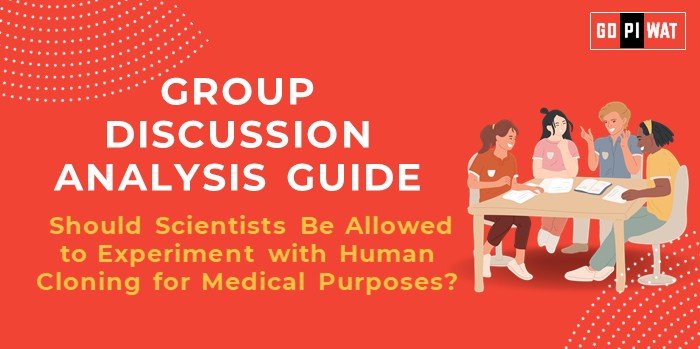📋 Group Discussion (GD) Analysis Guide: Should Scientists Be Allowed to Experiment with Human Cloning for Medical Purposes?
🌐 Introduction to Human Cloning for Medical Purposes
- Opening Context: Advances in genetic engineering and biotechnology have paved the way for controversial discussions on human cloning, particularly for medical breakthroughs like curing genetic disorders or creating organs for transplants.
- Topic Background: The concept of cloning was revolutionized with Dolly the sheep in 1996, raising ethical, societal, and scientific questions. As cloning technology progresses, its potential in regenerative medicine and disease research becomes more evident, yet ethical concerns persist globally.
📊 Quick Facts and Key Statistics
- 📅 First Mammal Cloned: Dolly the sheep (1996) – Sparked the cloning debate worldwide.
- 💰 Stem Cell Research Market Size: $15 billion in 2023 – Illustrates the importance of related biotechnologies.
- ❤️ Organ Shortages: 17 people die daily waiting for transplants in the U.S. – Highlights the potential life-saving impact of cloning.
- 🌍 Global Regulation: 70+ countries ban human cloning for reproduction, but therapeutic cloning is permitted in select nations.
👥 Stakeholders and Their Roles
- 💻 Scientists and Researchers: Pioneering the technology, driving innovation in regenerative medicine.
- 🏛️ Governments: Regulating cloning practices, balancing ethical concerns with scientific progress.
- 🏥 Medical Institutions: Potentially utilizing cloning for advanced treatments and organ transplants.
- ⚖️ Ethical and Religious Groups: Advocating moral considerations and human dignity.
🏆 Achievements and Challenges
✨ Achievements
- Advancements in Stem Cell Research: Therapeutic cloning has advanced regenerative medicine.
- Breakthrough in Organ Regeneration: Potential to address organ shortages and improve transplants.
- Genetic Disease Research: Cloning can create disease models for developing cures.
⚠️ Challenges
- Ethical Concerns: Debate over the morality of creating and using clones.
- Biological Risks: High failure rates and health problems in clones.
- Regulatory Hurdles: Diverse global regulations create inconsistencies.
📚 Structured Arguments for Discussion
- 💪 Supporting Stance: “Cloning for medical purposes can save lives by solving organ shortages and enabling groundbreaking disease research.”
- ❌ Opposing Stance: “Experimenting with human cloning raises profound ethical dilemmas and risks commodifying human life.”
- ⚖️ Balanced Perspective: “While human cloning for medical use holds immense promise, ethical guidelines and safety measures are paramount.”
💡 Effective Discussion Approaches
- 📊 Opening Approaches:
- “Over 100,000 people in the U.S. await organ transplants, underlining the urgency for medical advances like cloning.”
- “Does the potential to save lives justify experimenting with human cloning?”
- 🎯 Counter-Argument Handling:
- Ethical Concerns: “While ethical concerns are valid, strict regulations can ensure cloning is used responsibly.”
- Biological Risks: “Ongoing research addresses safety and efficacy to mitigate risks.”
🔍 Strategic Analysis of Strengths and Weaknesses
- ✅ Strengths: Potential to save lives, advances disease research, reduces organ shortage.
- ❌ Weaknesses: Ethical concerns, high costs, potential misuse.
- 🚀 Opportunities: Development of tailored therapies, scientific collaboration.
- ⚠️ Threats: Public opposition, regulatory bans, unforeseen biological risks.
🎓 Connecting with B-School Applications
- 📌 Real-World Applications: Links to healthcare management, bioethics, and technology innovation in B-school projects.
- ❓ Sample Interview Questions:
- “How should B-schools incorporate ethics into biotechnology management courses?”
- “What role do public-private partnerships play in advancing ethical biotechnologies?”
- 📘 Insights for B-School Students: Understanding bioethics prepares students for roles in healthcare and biotechnology industries.


